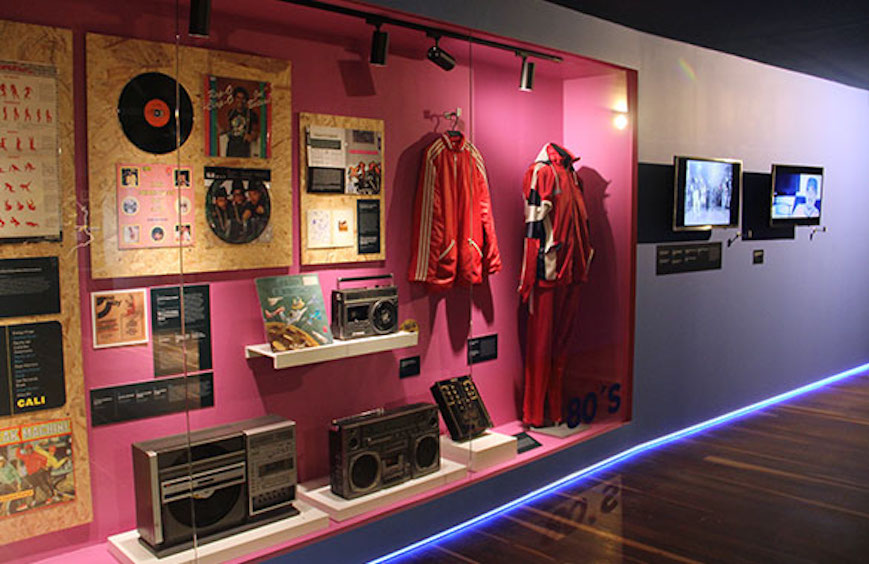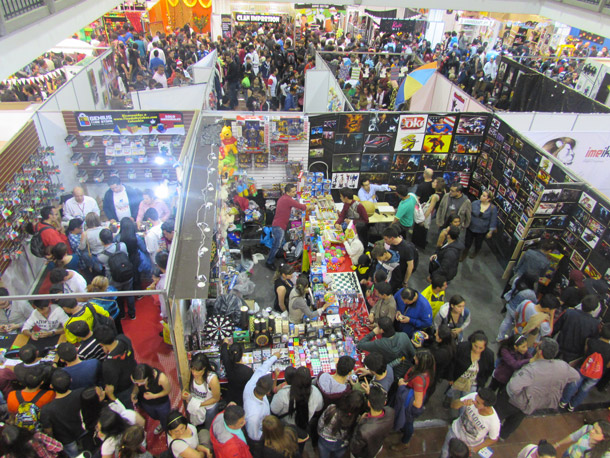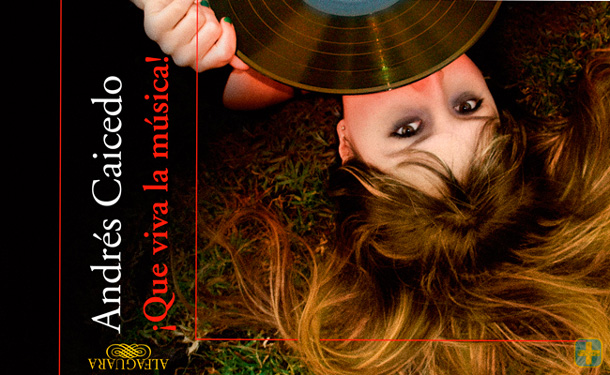Bogotá’s national museum offers the chance to clue up on all things hip-hop colombiano or simply indulge in some 90s nostalgia ahead of this year’s 25th anniversary of Hip-Hop al Parque.

The compelling rhythms and slang-ladden lyrics of paisas Alcolirykoz aren’t the traditional welcome visitors might expect on entrance into the Museo Nacional. Nor is it exactly the norm to stumble upon a fellow visitor tagging a wall in fluorescent pink marker without so much as a cursory glance from the attendant security guard.
But then Nación Hip-Hop: Colombia al Ritmo de una Cultura is far from the stuffy conservative fare one might expect from any other national history museum. Professional curators have teamed up with some of Colombian hip-hop’s biggest stars such as N.Hardem and La Etnnia, both of whom lit up Festival Cordillera last year, to transform the temporary exhibition hall into an energetic celebration of urban culture in Colombia.
Aiming to set the tone for its bicentennial year, the museum has pulled out all the stops, adopting a holistic approach that encompasses art, music, dance and fashion in order to plot the rise of hip-hop from a genre banished from commercial airwaves to an artform so respected that it has been the subject of three major exhibitions in Colombia in recent decades. Organisers have even gone so far as to arrange a host of free dance and music performances and workshops open to fans of all ages.
Whilst a commemoration of a culture that is less than a quarter of the museum’s age might seem an odd way to mark this major anniversary, the crowds of young exhibition-goers it attracts and the up-to-date curation both pay testament to the institution’s enduring relevance as an educational space and its desire to chronicle the popular history and culture of the nation as it unfurls.
2023 also marks a big year for hip-hop. Although things only really got going in Colombia in the mid-1980s, the genre first appeared on the world stage fifty years ago. This is also the 25th year of music-making for Bogotá’s Hip-Hop al Parque. By framing the Colombian hip-hop scene as a social movement as well as a cultural phenomenon, the exhibition loudly affirms its continuing purpose as a “voice for the voiceless” in the words of Zkirla, one of the artists to contribute to the curation.
The inclusion of protest placards and police riot shields from the 2021 protests, during which graffiti artists and rappers used their mediums to contribute to the mass demands for change, serve as a potent symbol that hip-hop is still as relevant as ever.
The exhibition offers novices a crash-course in hip-hop culture told through cassettes, denim jackets, spray-paint cans, and a carefully selected soundtrack, guiding visitors from the movement’s heavily US-influenced roots to the development of its uniquely Colombian sound, aesthetics and political undercurrent today.
The display opens with a dummy’s guide to the four central elements of hip-hop culture: breakdancing, djing, graffiti, and rapping, introducing key terminology like konke (dance floor) and b-girl/boy (breakdancer).
The exhibition then wends its way chronologically from the breakdance craze of the 1980s and initial debuts of Colombian rap, through to the troubled 1990s when rap artists were forced off the airwaves and lyrics became dominated by the big issues facing the country, such as conflict and drug-trafficking.
Despite the difficulties of the decade, this era is presented as the golden age of hip-hop colombiano; the years that gave birth to the Hip-Hop al Parque festival and saw the release of some of the scene’s most acclaimed work including La Etnnia’s debut full album ‘El ataque del Metano’ and Gotas de Rap’s seminal ‘Rap Opera’.
After revelling in the glory of the mid-90s, the exhibition once again moves on to highlight the transition out of estudios caseros into high-tech studios and the emergence of the producer as a key figure of influence in the current music scene.
Whilst the exhibition offers a perfect entry point for the hip-hop illiterate, those more familiar with the specifics of the genre needn’t fear. Alongside a heavy dose of nostalgia, it also includes several thoughtful details sure to elevate the experience for even the most knowledgeable hip-hop connoisseurs.
One such notable detail is the attention given throughout the exhibition to female contributions to the movement. These are marked out by a small purple symbol, allowing greater appreciation of the role played by women in a scene that is often seen as male-dominated, integrating them subtly throughout, without making them a sideshow.
There are also effective efforts to capture the spirit of the movement within the management of the space – a huge dancefloor acts as the exhibition’s centre piece, inviting visitors to break out into spontaneous performance and curators have aimed to democratise the space. Recently the future of the exhibition’s graffiti wall, an increasingly common attraction in Colombian galleries, was placed in the hands of social media users who were asked whether it should be painted over to make way for fresh tags.
Perhaps the most striking thing about Nación Hip-Hop is its distinctly triumphant tone. Its signage at times slips into near religious reverence, a sentiment which seems reflected in the crowd it attracts. As you make your way around the exhibition, you’ll no doubt have to wind your way through eager selfie-snappers and earnest fans explaining the finer details of certain cassettes to their patient partners.
In fact, the exhibition has proved such a huge hit, drawing in 700 visitors daily and thousands at weekends, that the museum has decided to extend its run for another two months. Rather than a detraction, this evident popularity among spectators is itself part of the exhibition’s charm. There’s something deeply infectious about the joy evident in both its curation and reception.
Nación Hip-Hop is open Tuesday-Sunday 9:00-17:00 until 16th April. The exhibition is included in the price of a regular Museo Nacional ticket. It’s worth noting that museum pricing strategies have proved controversial in recent months. Recently a row developed over a new tariff system that differentiates between Colombian citizens and foreign tourists. The latter must pay USD$10 for adults, the former COP$6,000. It’s likely that residents of Colombia will be permitted to pay the peso price, as with national parks, but you may have to argue at the ticket booth.





